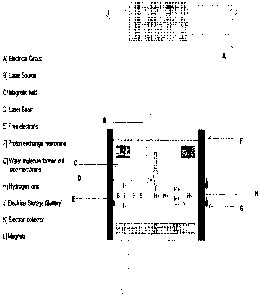Some of the information on this Web page has been provided by external sources. The Government of Canada is not responsible for the accuracy, reliability or currency of the information supplied by external sources. Users wishing to rely upon this information should consult directly with the source of the information. Content provided by external sources is not subject to official languages, privacy and accessibility requirements.
Any discrepancies in the text and image of the Claims and Abstract are due to differing posting times. Text of the Claims and Abstract are posted:
| (12) Patent Application: | (11) CA 2610584 |
|---|---|
| (54) English Title: | IONIZATION OF HYDROCARBON FUEL MOLECULE BY ELECTROMAGNETIC WAVES (LASER) PROVIDING IONIZATION ENERGY IN THE FORM PHOTONS TO CONVERT CHEMICAL ENERGY OF FUEL MOLECULE INTO ELECTRICALENERGY |
| (54) French Title: | PROCEDE D'IONISATION DE MOLECULES DE COMBUSTIBLE HYDROCARBONE AU MOYEN D'ONDES ELECTROMAGNETIQUES (LASER) FOURNISSANT L'ENERGIE D'IONISATION SOUS FORME DE PHOTONS, A DES FINS DE CONVERSION DE L'ENERGIE CHIMIQUE DES MOLECULES DE COMBUSTIBLE EN ENERGIE ELECTRIQUE |
| Status: | Deemed Abandoned and Beyond the Period of Reinstatement - Pending Response to Notice of Disregarded Communication |
| (51) International Patent Classification (IPC): |
|
|---|---|
| (72) Inventors : |
|
| (73) Owners : |
|
| (71) Applicants : |
|
| (74) Agent: | |
| (74) Associate agent: | |
| (45) Issued: | |
| (22) Filed Date: | 2007-11-15 |
| (41) Open to Public Inspection: | 2009-05-15 |
| Availability of licence: | N/A |
| Dedicated to the Public: | N/A |
| (25) Language of filing: | English |
| Patent Cooperation Treaty (PCT): | No |
|---|
| (30) Application Priority Data: | None |
|---|
Hydrocarbon fuel is exposed to laser (electromagnetic wave) of specific
wavelength in
absence of air to ionize fuel molecules. Hydrogen atoms in fuel molecule
become positively
charged hydrogen ions due in the process of ionization by electromagnetic
waves. The
hydrogen ions are passed through a proton exchange membrane to atmosphere
where it
combines with oxygen in the air to form water molecules. The positive charge
of hydrogen
ion is carried by proton exchange membrane in to electrical circuit. Free
electrons generated
in the process of ionization are collected by metal electron collector cathode
which carries
the electrons in electrical circuit.
The ionization of fuel is carried out in magnetic field which drives positive
ions toward proton
exchange membrane and electrons in opposite direction toward electron
collector cathode.
The process of ionization energy is to molecule in the form of laser
(electromagnetic waves).
The ionization energy breaks the C-H bond to make hydrogen ions.
The proton exchange membrane and metal electron collector are connected to
each other
through an electrical circuit through which electrical current flows due to
potential difference
in electrons and protons.
The molecular energy of hydrocarbon fuel is directly converted to electrical
energy in the
circuit without combusting fuel.
Note: Claims are shown in the official language in which they were submitted.
Sorry, the claims for patent document number 2610584 were not found.
Text is not available for all patent documents. The current dates of coverage are on the
Currency of Information
page
Note: Descriptions are shown in the official language in which they were submitted.

2024-08-01:As part of the Next Generation Patents (NGP) transition, the Canadian Patents Database (CPD) now contains a more detailed Event History, which replicates the Event Log of our new back-office solution.
Please note that "Inactive:" events refers to events no longer in use in our new back-office solution.
For a clearer understanding of the status of the application/patent presented on this page, the site Disclaimer , as well as the definitions for Patent , Event History , Maintenance Fee and Payment History should be consulted.
| Description | Date |
|---|---|
| Inactive: IPC deactivated | 2016-01-16 |
| Inactive: IPC deactivated | 2016-01-16 |
| Inactive: IPC deactivated | 2016-01-16 |
| Inactive: IPC assigned | 2016-01-01 |
| Inactive: IPC assigned | 2016-01-01 |
| Inactive: IPC expired | 2016-01-01 |
| Inactive: IPC expired | 2016-01-01 |
| Inactive: IPC expired | 2016-01-01 |
| Inactive: First IPC assigned | 2016-01-01 |
| Inactive: IPC assigned | 2016-01-01 |
| Time Limit for Reversal Expired | 2010-11-15 |
| Application Not Reinstated by Deadline | 2010-11-15 |
| Deemed Abandoned - Failure to Respond to Notice Requiring a Translation | 2010-09-02 |
| Inactive: Adhoc Request Documented | 2010-08-19 |
| Inactive: Incomplete | 2010-06-02 |
| Deemed Abandoned - Failure to Respond to Maintenance Fee Notice | 2009-11-16 |
| Application Published (Open to Public Inspection) | 2009-05-15 |
| Inactive: Cover page published | 2009-05-14 |
| Inactive: IPC assigned | 2008-05-12 |
| Inactive: First IPC assigned | 2008-05-12 |
| Inactive: IPC assigned | 2008-05-12 |
| Inactive: IPC assigned | 2008-05-12 |
| Inactive: IPC assigned | 2008-05-09 |
| Inactive: IPC assigned | 2008-05-09 |
| Filing Requirements Determined Compliant | 2008-01-04 |
| Inactive: Filing certificate - No RFE (English) | 2008-01-04 |
| Application Received - Regular National | 2007-12-20 |
| Small Entity Declaration Determined Compliant | 2007-11-15 |
| Abandonment Date | Reason | Reinstatement Date |
|---|---|---|
| 2010-09-02 | ||
| 2009-11-16 |
| Fee Type | Anniversary Year | Due Date | Paid Date |
|---|---|---|---|
| Application fee - small | 2007-11-15 |
Note: Records showing the ownership history in alphabetical order.
| Current Owners on Record |
|---|
| GLOBAL MERCHANT CORP |
| Past Owners on Record |
|---|
| UNKNOWN |